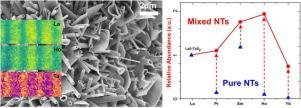Applied Materials Today ( IF 7.2 ) Pub Date : 2020-02-07 , DOI: 10.1016/j.apmt.2020.100581 M. Serra , L. Lajaunie , M.B. Sreedhara , Y. Miroshnikov , I. Pinkas , J.J. Calvino , A.N. Enyashin , R. Tenne

|
The non-stoichiometric misfit layered compounds (MLC) of the general formula ((MX)1+y)m(TX2)n (abbreviated herein as MX-TX2) have been investigated quite extensively over the last 30 years. Here MX is a atomic slab of a material with distorted rocksalt structure and TX2 is a layered compound with hexagonal (octahedral) coordination between the metal T atom and the chalcogen X atom. Recognizing the mismatch between the two (MX and TX2) sublattices, nanotubes from the MLC of different compositions were described in the past. In particular, semimetallic nanotubes belonging to the family LnX-TaX2 with Ln = rare earth atom and X = S, Se, Te have been studied in the past. While some of them, like LaS-TaS2 were obtained with moderately high yields, others like YbS-TaS2 were scarce. In the present study, a new strategy for promoting the yield of such MLC nanotubes by alloying the LaS sublattice with another Ln atom is proposed. Detailed transmission electron microscopy investigation of the (mixed) LnxLa(1-x)S-TaS2 (Ln = Pr, Sm, Ho, Yb) nanotubes show clearly that the substituting Ln atom resides in the rocksalt LaS sublattice of the nanotubes. Raman measurements show distinct differences between mixed tubes with open-shell (Pr, Sm, Ho) and close-shell (La, Yb) rare-earth atoms. Density functional calculations show that the interplay between two important factors determine the enhanced stability of the mixed nanotubes- the size and electronic structure of the substituting rare-earth atom. The smaller is the substituting rare-earth atom (larger Z number), the more dissimilar it is to the original La atom. This dissimilarity enhances the incommensurability between the LnxLa(1-x)S and the TS2 subunits, promoting thereby the stability of the mixed MLC. However, the electronic structure of the Ln atom was found to play a more significant role. The MLC lattice of the LaS-TaS2 is electron-rich and consequently the 4dz2 level of Ta is full. The unoccupied 4f levels of the substituent open-shell atoms (Pr, Sm, Ho), which are positioned below the Fermi level, serve as electron acceptors. Consequently, the Ln substitution is found to enhance the stability of the mixed lattice and nanotubes thereof. This strategy can be employed for enhancing the yield of these and other misfit nanotubes using different substituents of the right size and energy profile.
中文翻译:

Ln x La (1-x) S-TaS 2纳米管(Ln = Pr,Sm,Ho和Yb)作为提高错配纳米管收率的媒介
在过去的30年中,对通式((MX)1 + y)m(TX 2)n(本文简称为MX-TX 2)的非化学计量失配层状化合物(MLC)进行了广泛的研究。此处,MX是具有扭曲的岩盐结构的材料的原子平板,而TX 2是金属T原子与硫族元素X原子之间具有六边形(八面体)配位的层状化合物。认识到两个(MX和TX 2)亚晶格之间的不匹配,过去描述了来自不同成分的MLC的纳米管。特别是属于LnX-TaX 2族的半金属纳米管过去已经研究了Ln =稀土原子和X = S,Se,Te。尽管其中一些(如LaS-TaS 2)以中等高的收率获得,但其他一些(如YbS-TaS 2)却很少。在本研究中,提出了通过将LaS亚晶格与另一个Ln原子合金化来提高此类MLC纳米管产率的新策略。(混合)Ln x La (1-x) S-TaS 2的详细透射电子显微镜研究(Ln = Pr,Sm,Ho,Yb)纳米管清楚地表明,取代的Ln原子驻留在纳米管的岩石盐LaS亚晶格中。拉曼测量结果显示,具有开壳(Pr,Sm,Ho)和闭壳(La,Yb)稀土原子的混合管之间存在明显差异。密度泛函计算表明,两个重要因素之间的相互作用决定了混合纳米管的增强稳定性-取代稀土原子的尺寸和电子结构。取代的稀土原子越小(Z数越大),它与原始La原子的相似度越高。这种差异增加了Ln x La (1-x) S与TS 2之间的不可通约性亚基,从而提高了混合MLC的稳定性。然而,发现Ln原子的电子结构起更重要的作用。LaS-TaS 2的MLC晶格富含电子,因此Ta的4 d z 2能级充满。处于费米能级以下的取代基开壳原子(Pr,Sm,Ho)的未占据的4 f能级充当电子受体。因此,发现Ln取代增强了混合晶格及其纳米管的稳定性。该策略可用于通过使用具有正确尺寸和能量分布的不同取代基来提高这些和其他错配纳米管的产率。











































 京公网安备 11010802027423号
京公网安备 11010802027423号